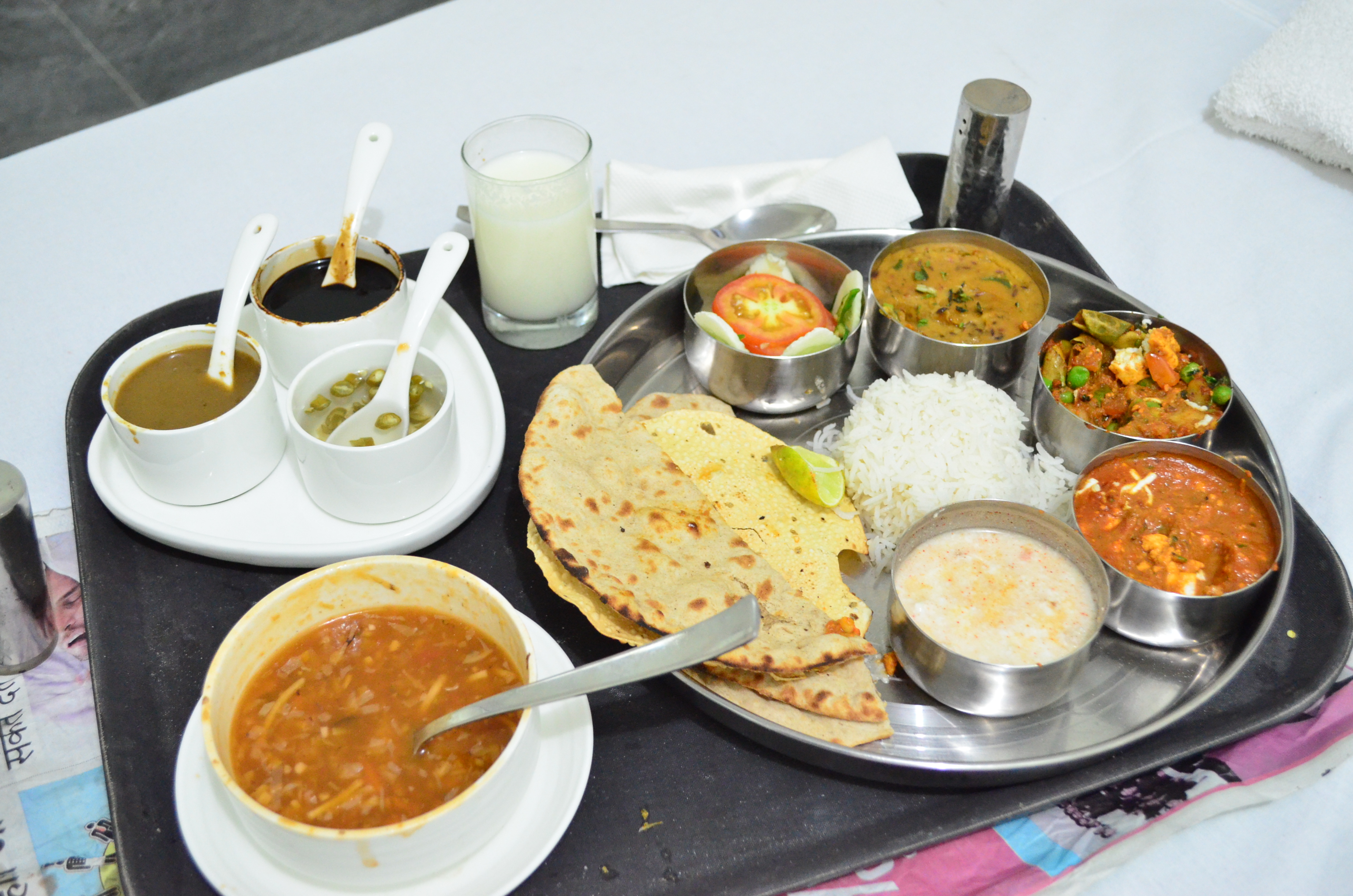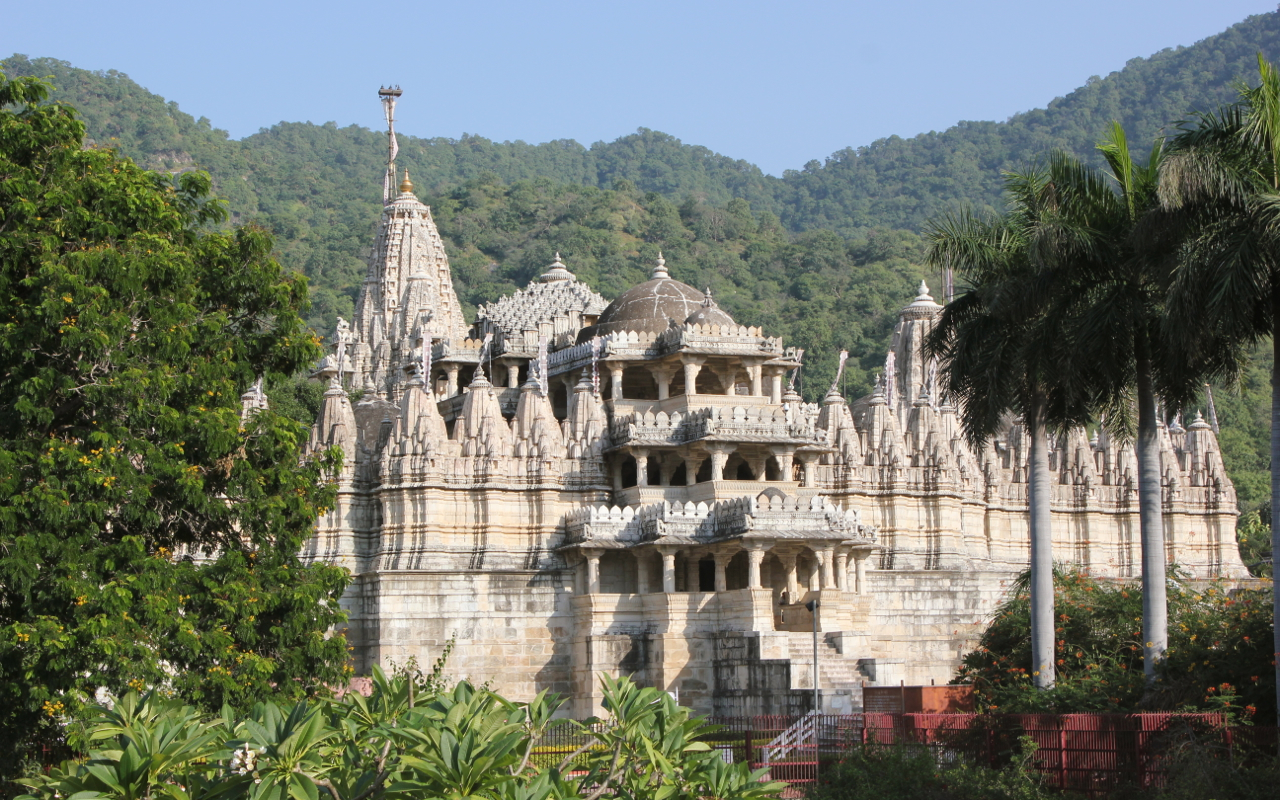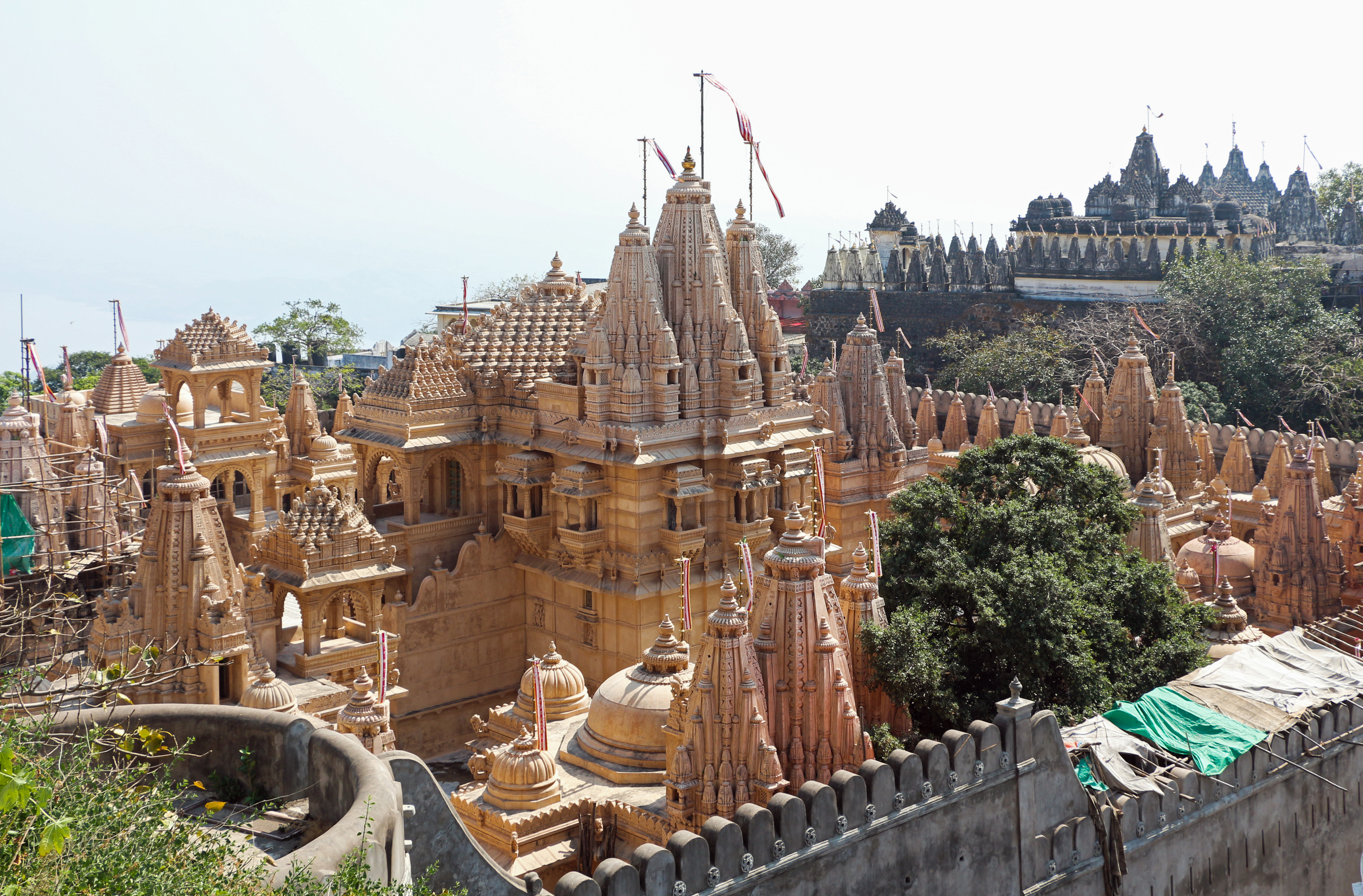 |
| Jain Temple, Palitana, Gujarat Bernard Gagnon, CC BY-SA 3.0, via Wikimedia Commons |
India is renowned for its vibrant diversity of religions, art forms, and architecture. Among these, Jain architecture stands out with its purity of design, symmetry, devotion to detail, and spiritual symbolism.
Ancient Jain architecture is not just stone and sculpture—it manifests religious ideals: non-violence, austerity, purity, detachment, and a profound sense of cosmic order.
The temples, shrines, caves, and tirthas (pilgrimage sites) built over centuries reveal how Jain communities expressed faith through art, how they patronised architecture, and how they interacted with regional styles while maintaining distinctive elements.
Historical & Religious Foundations
Jainism is one of the oldest religions of India, teaching the path of non-violence (ahimsa), truth (satya), non-stealing, celibacy, and non-attachment. From early times, Jains built places of worship (derasars, basadis), monastic retreats, small reliefs, images of Tirthankaras (spiritual teachers), and halls for meditation and ritual assembly. During the early centuries CE, and more so in the first millennium, Jainism had patronage under various kings and merchant guilds, which enabled development of elaborate architecture.
Religious symbolism permeates the architectural forms:
-
The Tirthankara image (often in seated or standing posture) is central. Sanctum (garbhagriha) houses the deity; devotees come to see and venerate.
-
Multiple shrines around a temple complex allow devotion to various Tirthankaras.
-
Architectural layout often reflects Jain cosmology: symmetry, balance, multiple directions (nirvana in various corners), mandapas, corridors for circumambulation.
-
Decoration of ceilings, pillars, doorways in highly refined stone work reflects not only aesthetic but devotional discipline.
-
Use of marble or fine stone emphasizes purity; white or lightly coloured stone is common in many major Jain temples, symbolizing purity and detachment.
Over centuries, Jain architecture intersected with regional styles (Nagara, Dravidian, Māru-Gurjara, etc.), adapted to climate and materials, but maintained its own identity through certain features: intricate carving, symmetrical layouts, temple complexes set in hills or elevated sites, and a strong sense of inner calm even amid ornamentation.
Seven Must-Visit Jain Architectural Wonder Sites in India
To appreciate Ancient Jain architecture, here are at least seven extraordinary temples or temple complexes, each a treasure of craftsmanship, religious importance, history, and aesthetic wonder.
| No. | Site | |||
|---|---|---|---|---|
| 1. Dilwara Temples, Mount Abu (Rajasthan) |
The Vimal Vasahi and Luna Vasahi temples are among the most famous. Light coloured marble lends an inner glow; corridors and mandapas give spaces of both silence and ritual activity. This site shows how Jain architecture achieved refinement in both outer structure and inner detail. | |||
| 2. Ranakpur Jain Temple (Rajasthan) |
The Chaumukha (four-faced) temple with four entrances leading into a central sanctum, surrounded by many sub-shrines. It is famous for 1,444 intricately carved pillars, none exactly alike; numerous domes; halls, mandapas with elaborate carvings; natural marble that changes its tones with daylight. The layout, scale, and detail combine to provide both visual grandeur and devotional intimacy. | |||
| 3. Palitana Temples, Shatrunjaya Hills (Gujarat) |
Marble shrines, towers (shikharas), ornate exteriors and interiors; steep and numerous steps up the hill; sanctuaries with richly ornamented carvings. The main shrine (Adinath) and many smaller ones are beautifully done. As a place of pilgrimage, it holds religious centrality along with architectural beauty. | |||
| 4. Shravanabelagola (Karnataka) |
The Chavundaraya Basadi, Akkana Basadi are examples. Basadi architecture shows vaulted ceilings, sculpted pillars, open and closed halls, complex reliefs. The combination of monoliths, caves, and built temples in the hill-landscape make it unique. | |||
| 5. Sonagiri Temples (Madhya Pradesh) | A set of Jain temples on hilltops, with many small shrines and one or more central large temples. The hill pilgrimage path, sculpted idols, serene spaces, devotional walks, elaborate relief work combine to make this a place of both spiritual commitment and architectural interest. | |||
| 6. Taranga Jain Temple (Gujarat) | Located near Mehsana, built in the 12th century by Solanki king Kumarapala, this temple shows Māru-Gurjara style: elaborate carvings, shikhara (tower over the shrine), decorated doorways, ornate pillars, open mandapas, sculptural detail. The temple compound often contains several shrines with enclosed courtyards. | |||
| 7. Kirti Stambha, Chittor Fort (Rajasthan) |
Carved niches, decorative motifs, vertical structure; a symbol of Jain victory as well as mark of devotion. It reflects interplay of martial, religious, and artistic cultures. |
Beyond these, many more lesser-known or partly ruined but significant sites—cave temples, small basadis, Tirtha-shrines—exist throughout India, testifying to the spread and endurance of Jain architectural tradition.
Styles, Materials & Architectural Characteristics
To understand what makes ancient Jain architecture distinct, here are some shared and variational features:
-
Marble and fine stone: Many prime Jain temples use white or light-coloured marble. Marble allows for very fine carving, smooth finish, translucence in certain lights. Marble also symbolizes purity.
-
Māru-Gurjara style (also Solanki style): Characterised by rich carvings, ornate shikharas, open mandapas, very intricate ceilings, ceilings with concentric circles, detailed pillars, brackets, decorative arches. This style flourished especially in western India (Gujarat, Rajasthan).
-
Shikharas (temple spires): Towers above sanctum that often are tiered, with miniature spires, turrets, finials.
-
Mandapas, halls, corridors: Multiple mandapas (pillared halls) for gathering; rangamandapa or dance hall; enclosed sanctum; open pillared halls.
-
Carved ceilings, pendentives, ornate domes: In the larger temples, ceilings are beautifully decorated with motifs: lotuses, yogic symbols, mythical beings, stories.
-
Courtyards, enclosures, multiple shrines: Temple complexes are rarely single-shrine. Many smaller shrines surround a main temple; enclosures for pilgrims to walk, meditate, circumambulate; hill-site temples often spread across terraces.
-
Symmetry, cosmic symbolism: Layouts often reflect cosmological ideas: four directions, balance, light and shadow, geometry. Some temples are built with orientation to rising sun, features aligning with cardinal axes.
-
Relief sculpture & iconography: Images of Tirthankaras in various postures; attendant deities; yakshas, yakshinis; mythic creatures; floral and geometric ornament; stories from Jain literature in panels.
-
Durability and ornament-versus structural clarity: While aesthetics are highly ornamented, structure remains clear; engineering adapted to local topography; roof loads, dome transitions, use of natural ventilation, etc.
Religious & Cultural Importance
-
Jain temples are pilgrimage centres: physical acts of devotion—visiting, climbing hill-paths, walking around shrines, offering prayers. Sites like Palitana, Sonagiri, Shravanabelagola are deeply sacred, attracting pilgrims from across sects.
-
The temples serve not only puja (worship) but also spaces for meditation, community gatherings, teaching, ritual observances.
-
The architecture itself is religious imagination in stone: reflecting ideals of non-attachment (temple as a place to transcend daily life), purity, calm, order.
-
Patronage by kings, merchants, Jain communities over centuries preserved the tradition; these buildings represent faith, identity, community values.
-
Many sites have survived invasions, climatic wear, neglect—so they also embody preservation of cultural memory.
What to See When Visiting These Sites
If you travel to these temples, to fully appreciate them:
-
Observe the pillars: Are they carved? Each one unique? What motifs—flowers, dancers, mythic animals?
-
Look at ceiling work: Concentric rings, pendant motifs, lotus buds, geometric interlacings.
-
Note the doorways and entrances: Thresholds often highly ornamented; sometimes there are flagstones, engraved lintels, ornate toranas.
-
See the shikhara architecture: How many tiers? Are there miniature spires? Finials? How do they relate to the sanctum?
-
Explore courtyards, sub-shrines: Many sites are not one temple but many; walking paths, enclosures.
-
Sense the use of light and material: How marble glows in morning light; open mandapa halls vs enclosed sanctums.
-
Feel the devotional ambience: ritual sounds, chanting, incense, artwork that tells stories; presence of pilgrims.

Indian Vege Thali (Dish)
Asif Saleh, CC BY-SA 4.0, via Wikimedia Commons
How Tasty the Local Indian Food Is: A Jain & Regional Flavour

Asif Saleh, CC BY-SA 4.0, via Wikimedia Commons
Architecture feeds the spirit; food feeds the body—and both are essential parts of any travel experience.
Indian food, especially vegetarian and Jain-sensitive food, is delicious in its diversity, subtlety, textures, and freshness. Sampling food near Jain temples or in towns where these monuments are located adds a wonderful dimension to pilgrimage or heritage travel.
Key Characteristics of Jain / Regional Food
-
Strict vegetarian fare: Jain diet often omits root vegetables, garlic, onion in many places, focusing on ingredients that grow above ground; this leads to use of lentils, grains, dairy, fruits, vegetables like beans, green leafy vegetables.
-
Simple yet rich: Use of ghee, milk, yogurt; spices used with restraint and balance; emphasis on clarity of taste.
-
Regional produce: Each region has output—marble-hill areas may use dairy; Rajasthan has pulses, millet; Gujarat has sweet and tangy notes; South India has rice, coconut, tamarind; Karnataka slopes have fresh vegetables, coconut, jaggery.
-
Snacks & sweets: Offerings unusual, often local specialties; mild desserts are common; food is often served with decorative gestures (flowers, colored powders, etc.)

North Indian Vege Thali (Dish)
Prav2991993, CC BY-SA 4.0, via Wikimedia Commons
Examples of Delicious Local Food Around Jain Heritage Sites

Prav2991993, CC BY-SA 4.0, via Wikimedia Commons
-
Near Rajasthan temples (e.g. Ranakpur, Mount Abu, Palitana): Dal (lentils), bajra (pearl millet) rotis, ghee-rich sweets; sweets like mawa-ladoos, ghevar, milk-based sweets; vegetable preparations often dry or slightly saucy; locally made lassis, buttermilk.
-
In Gujarat (Palitana, Taranga): Gujarati thali style meals—rice, rotla or phulka (flatbreads), multiple vegetable bhajis (cooked and dry), dal, kadhi, pickles; sweets like shrikhand, jalaru, also snacks like khakhra or fafda.
-
In Karnataka (Shravanabelagola etc.): Rice preparations, coconut chutney, sambar, idli or dosa in Jain-sensitive versions; vegetable stews; sweets made of jaggery or local sugar; fresh fruit; coffee or fresh tea.
-
On pilgrimage paths (hill climbs, many temples): small shops/huts serving simple but nourishing food: khichdi (rice + lentils), sweet curd, chai, roasted nuts, fruits, simple sabzi with chapati; these feel particularly satisfying after walks and stairs.
How Food Enhances Architecture Travel
-
After exploring cool marble halls, stepping out to sunlight and having a cool lassi or buttermilk feels refreshing.
-
The local food often uses local ingredients, echoing region, climate, culture—just as architecture uses local stone, style.
-
Food is part of pilgrimage: feeding the body is akin to feeding the spirit; many temples have charitable kitchens (bhojanalayas) offering free or low-cost food.
-
Sharing meals with locals, trying recipes passed down in temple towns or merchant communities gives context and warmth to the travel experience.
An Integrated View: Why Ancient Jain Architecture & Local Cuisine Matter Today
-
These temples are physical heritage, embodiments of aesthetic, spiritual, and social values. They teach us what devotion, craftsmanship, and community can create.
-
They also show sustainable building practices: using local stone, passive cooling, natural materials—less dependency on imported materials or energy.
-
In modern tourism, they form heritage-tourism anchors; responsible travel, conservation, supporting local communities (artisans, temple caretakers, food vendors) matters.
-
Local vegetarian/Jain food is healthier, often more sustainable, less demanding on land; can be inspiration for travelers seeking lighter or ethical diets.
-
In a globalised world, ancient craftsmanship and local flavors offer a rootedness—a way to connect with history, nature, diversity.
Conclusion
Ancient Jain architecture is one of India’s treasures: a fusion of devotion, artistry, geometry, and spiritual intent. Temples like Dilwara, Ranakpur, Palitana, Shravanabelagola, Taranga, Sonagiri, Kirti Stambha - each shows how human hands shaped stone and marble into vessels of peace and grandeur. Visiting these places, observing the pillars, shikharas, ceilings carved with myth and symbol, one senses not just history, but timeless ideals.
Paired with this is the local food: vegetarian, refined, seasonal, soulful. It complements the spiritual walk, revives the pilgrim’s weary feet, enriches the senses. The hush of a marble hall followed by the taste of fresh sweet curd, lentils, subtle spices, or jaggery-sweetened treats—this is part of the journey.
For anyone interested in religion, architecture, art, culture, or food: exploring Jain heritage in India offers a rich tapestry. It calls to slow observation, respectful presence, curiosity. And it rewards with beauty that endures, taste that lingers, and a deeper sense of what human faith and craftsmanship can create.
Sources
-
Encyclopedia entries on Ranakpur Jain Temple
-
Archaeological and architectural studies of Dilwara Temples
-
Material on Palitana temple complex history and architecture
-
Scholarship and travel reports on Shravanabelagola basadis and monumental statue of Bahubali
-
Studies of Taranga, Sonagiri, Kirti Stambha temples
-
Regional food culture sources from Rajasthan, Gujarat, Karnataka



